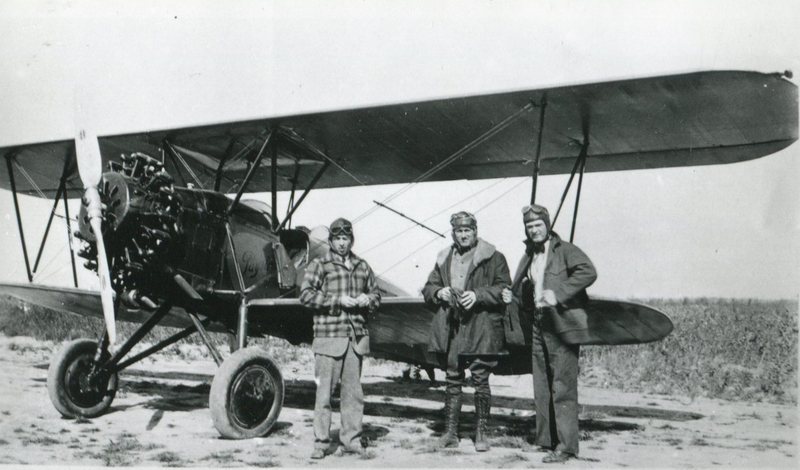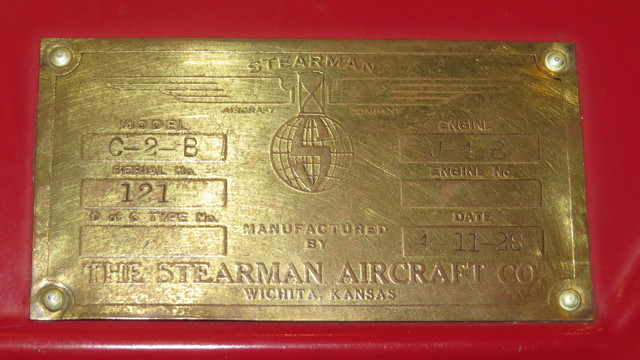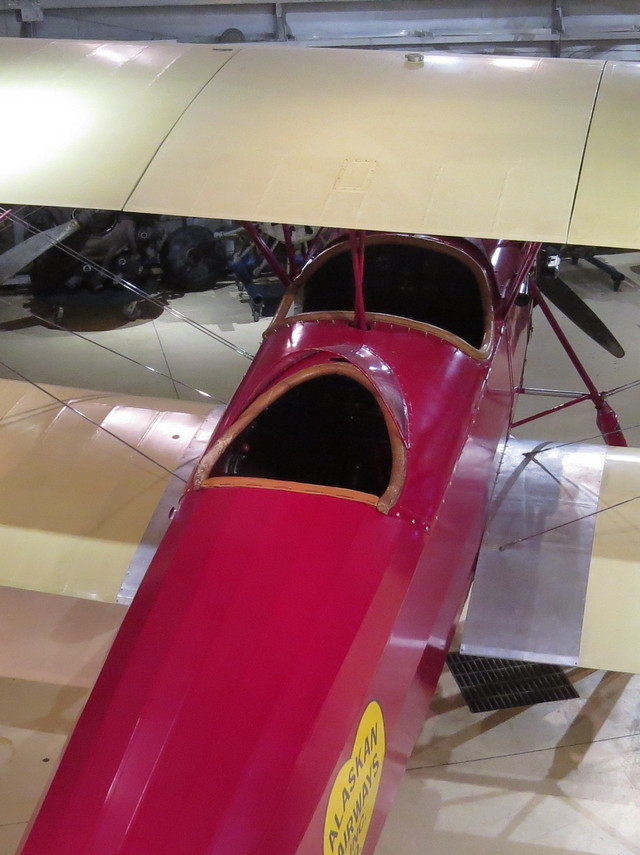airhistory.org - Stearman NC5415
NC5415 - Stearman C-2B > C-3B C/N: 121 Pacific Alaska AW/NJ
| Stearman Home >> | AAM 1928 Stearman NC5415 History |


A little history of the Stearman aircraft, model C2B. The first of these aircraft came off the assembly line in Wichita, Kansas in January of 1928. Over the years this model flourished and with changes from time to time was used for many purposes. In the 1930’s and 40’s nearly 10 thousand were built and used by the military to train pilots. In that mode it was designated the PT-17 (Primary trainer). Following WWII, many were converted for use in agriculture as crop dusters which required an engine with far more horsepower.
Stearman N5415 that you see here in Hanger 1 was built in the first year of production, 1928. It was first sold on April 13th, 1928 to (Wikipedia) - Walter Varney in San Leandro, CA without an engine. Varney founded the forerunners of United Airlines and Continental Airlines. The equipment that was installed included a flight indicator, a Waltham 8 day clock, a speed and drift indicator, navigation lights with battery container, wiring and equipment for landing lights and Wiley flares. Many early aircraft had 2 or 3 flares mounted inside the wing with an easily dislodged cover on the underside. If a pilot was flying at night and had an engine failure or other emergency, he or she could cause the flares to be released and illuminate the ground below the plane.
Other data about this plane includes that it has a 220 HP Wright J-5, 9 cylinder engine. There is an engine data plate on the front of the engine under the crankshaft. The edge of the data plate is visible if you look with a flashlight. With a flashlight and a flexible inspection mirror, you can read the data plate (backwards). Its upper wing span is 35 feet, and the lower 28 feet. The plane is 24 feet, 9 inches long and it has a cruising speed of 104 miles per hour.
On October 27, 1928 the first application for an Aircraft license states the aircraft had been in California until June of that year and that it now was located in Alaska. In January, 1934 a letter to the Aeronautic Branch of the Department of Commerce stated that the aircraft should be approved as a land plane and also to operate as a seaplane using Edo floats (then called pontoons). Use as a land plane includes operation on skis.
During its time in Alaska, N5415 was owned by several firms and flown by a number of individuals. These included Arctic Prospecting and Developing Company of Fairbanks (certificate signed by Walter Varney) in June of 1928, to Noel Wien of Alaska Airways in October of 1928, to Alaska Airways of Fairbanks, Merle Smith who was the owner of Cordova Airlines, and a Mr. Les Kares. In 1932 this plane was one of the first to land on Denali. The plane crashed in the Wrangell Mountains and was later restored by Mr. Kares over a 10 year period while living in Montana.
Harold Gilliam flew NC5415 while searching for the lost Wien Metalplane (around the corner) piloted by Ben Eielson and Borland.
N5415 was also flown by Joe Crosson who is regarded as perhaps the greatest pilot in Alaskan aviation history. One of his major accomplishments was a daring mission to deliver 280,000 units of diphtheria serum to the Arctic coast, saving villages from being decimated by the plague. His many extraordinary flying feats, beginning in 1926, justify his reputation as the greatest pilot in Alaskan aviation history. His biography is available for sale in our museum store.
In 1936 the Stearman was sold to “Mudhole” Smith’s Cordova Air Service, and he was flying this plane when he got his nickname.
This aircraft has a “noticeable” accident record with damage reports in March 1938, April 1938, September 1938, and July 1939. The late 1930's were tough on this Stearman. It was sold to The Alaska Aviation Museum in December of 1991.




airhistory.org - Stearman NC5415
NC5415 - Stearman C-2B > C-3B C/N: 121 Pacific Alaska AW/NJ
edcoatescollection.com - Stearman NC5415
American Airlines used a fair number of Stearmans in the lower 48 states for the carriage of mail. Clearly this one was seconded to their Alaskan Airways Division. The machine carries the somewhat obtuse name of "Paystreak". It was built as a C-2B and converted before this photo was taken to C-3B standard. This image is from the archives of the Museum of Transportation & Industry (via Lars Opland).
11 April 1928 - Build Date
13 April 1928 - Aircraft sold to Walter T. Varney, of Aircraft Industries, San Leandro, CA. It was sold without the engine. The installed equipment included, a flight indicator, 8 day clock (Waltham), speed and drift indicator, navigation light with battery container, wiring and equipment for landing lights and Wiley flares. The aircraft cost $3,400.00 without the engine, with the equipment installed the total cost was $3,981.00.
(On April 6, 1926 Varney Airlines, owned by Walter T Varney, flew the first scheduled airline service in the US, an airmail route between Pasco, WA and Elko, NV. Varney Airlines evolved into what we know today as United Airlines. In 1934 he founded Varney Speed Lines, which evolved into Continental Airlines.)
11 June 1928 - Sold to the Arctic Prospecting & Developing Company, Fairbanks, Territory of Alaska. This document states the model number as a new C2B with a rebuilt Wright whirlwind J4B engine. This document was signed by Walter Varney.
1 October 1928 - Sold to Wein Alaska Airways, Fairbanks, Territory of Alaska. The other side of this document is dated 19 December 1929.
25 October 1928 - Letter from the Dept. of Commerce to Walter T. Varney stating that the temporary license number 5415, for Stearman S/N 121, had been canceled because proper application for the number had not been received.
27 October 1928 - First application for an Aircraft license states the aircraft had been in California, until sold in June and was now in Alaska. This form also stated the aircraft was new but the engine had been rebuilt by the Varney Airmail Line shops in Boise, ID
29 October 1928 - Telegram reinstating temporary license number 4515.
April 1929 - Accident landing with wheels on snow covered Walker Lake, 260 miles northwest of Fairbanks
14 September 1929 - Sold to Alaska Airways Inc. Fairbanks, Territory of Alaska, a division of the Aviation Corp (AVCO), Carl Ben Eielson Vice President.
1 November 1929 - Application for Commercial License states the aircraft was completely rebuilt, including a new set of wings, the fuselage was recovered and the motor rebuilt by Thomas Gerard, Master Mechanic. This document gives the purchase date as 6 August 1929 and shows Ben A. Eielson as Vice President.
26 Jan 1930 - Harold Gillam and Crosson found the Metalplane wreck of Eielson and Borland.
March 10, 1930 - NC4515 flown by Harold Gillam was part of the flight of planes bringing the bodies of Eielson and Borland were back to Fairbanks.
1 June 1930 - The aircraft received it's first commercial airplane
license and the “N” number became NC4515.
The various licenses that were issued when this aircraft was new were comparable to the Airworthiness Certificates used today. The identification number would change depending on what license was in effect at the time; example, 4515, C4515, NC4515 and it could be cancelled by the Dept. of Commerce or the owner for various reasons. Only licensed pilots could legally fly an aircraft with a letter prefix. If the number had no letter prefix, as in 4515, then it was limited to commercial operations wholly within one state and licensed pilots were specifically prohibited from flying it while carrying persons or property for hire. C and NC were commercial airplane licenses, R and NR were restricted licenses and X and NX were experimental licenses. These licenses were issued semi-annually.
12 November 1931 - Operation Inspection report, form AB-80, states the aircraft is a C2B with C3B wings, the center section had been rebuilt and the ship recovered completely. This report listed the aircraft as a C2B.
3 May 1932 - Second plane to make a glacier landing on Mt. McKinley.
14 May 1932 - Mt. McKinley Cosmic Ray Expedition return flight. They had to flood the Fairbanks aviation field by cooperation with the fire department and make it sufficiently muddy and slippery to get a small powerful plane off on skis without the aid of a frozen surface.
1 September 1932 - Record of transfer of aircraft from Alaska Airways Inc to Pacific Alaska Airways Inc shows the aircraft model number changed from C2B to C3B. Thru out the history of this aircraft, the model changes back and forth with no explanation.
8 November 1932 - Accident at Skagway, Territory of Alaska.
13 March 1933 - Northwest Air Service, an approved repair station located at Boeing Field in Seattle, WA completed major repairs which included replacing or repairing most of the landing gear, lower fuselage structure and the wings. The damage was probably caused by the accident that generated the telegram in the next entry.
21 March 1933 - Telegram reporting the possibility of an accident. It told the local inspector to investigate and if true then the aircraft should be grounded.
23 March 1933 - Operation inspection report, form AB-80, shows accident occurred at Skagway, Territory of Alaska, on 8 November 1932. This report list the aircraft as a C3B. Remarks section states the aircraft was changed to conform from a C2B to a C3B. The model designation changes back and forth thru out the records of this aircraft.
12 November 1933 - Inspection report, form AB-80, states that skis had been approved and listed the weight as 78 lbs, that's a lot of skis. These skis were later listed several times as Alaska Airways model C3B skis. They were probably manufactured in the Alaska Airways shop in Fairbanks, Territory of Alaska.
2 January 1934 - Letter to Aeronautic Branch of the Dept. of Commerce stating that S/N 121 had been approved as a landplane only but should have been approved as a land and seaplane, with Edo P(3300) pontoons, when used as a seaplane. The change was approved.
16 January 1936 - Form letter to Pacific Alaska Airways states the license had been cancelled because purchaser had failed to submit proper document for transfer of title
11 February 1936 - Letter from the Dept. of commerce notifying Pacific Alaska Airways Inc that NC4515, S/N 121, had been found unairworthy and the NC must be removed from the aircraft before it was flown again.
5 June 1936 - Sold to “Mudhole” Smith’s Cordova Air Service, Cordova, Territory of Alaska.
10 June 1936 - Application for Commercial License by Cordova Air Service, shows aircraft on Edo 9-3300 floats and that the end struts and the right front center section strut had been shortened 3/4 of an inch.
17 August 1936 - Dept. of Commerce form AB-16, Record, Transfer and Reassignment form, shows transfer of ownership to Cordova Air Service, Cordova, Territory of Alaska. The cost for the aircraft, spare engine, Edo 3300 floats and miscellaneous spares was $1,500.00.
7 March 1938 - Accident
12 April 1938 - Repair and Alteration form documents extensive repairs to fuselage, engine and propeller. Refers to accident on 7 March 1938.
29 April 1938 - Accident
15 May 1938 - Repair and Alteration form documents replacing plywood leading edge of both upper wings and the center section. Both upper wings recovered. Refers to accident on 29 April 1938.
10 September 1938 - Accident
12 October 1938 - Repair and Alteration form documents repairs to wings and the replacement of the right landing gear. Refers to accident on 10 September 1938.
2 July 1939 - Accident
1 August 1939 - Repair and Alteration form documents replacement of left landing gear and minor repairs to lower left wing. Refers to accident on 2 July 1939.
3 June 1939 - Application for renewal of Airworthiness Certificate is signed by Merle K. Smith, then President of Cordova Air Service, Merle K. Smith is one of the more famous Alaskan bush pilots.
4 June 1939 - Aircraft inspection report gives the aircraft total time as 2,039.50 hours.
3 April 1968 - Letter, with Alaska Airline letterhead, signed by C.F. Willis Jr. to a Mr. Baxter, states that he had the registration plate (Data Plate) for Stearman C3B. This letter suggested Mr. Baxter contact Merle K. Smith, Vice President, Alaska Airlines, in Anchorage, AK for information about this aircraft, as he was the one that owned it at the time of the crash.
29 May 1968 - Letter from C.F. Willis forwarding Stearman plate (data plate) to R.L. Baxter of Seattle, WA.
29 May 1969 - Notarized letter stating Richard L. Baxter released all interest in N5415, Stearman C2B, S/N 121, to Les R. Kares.
6 June 1969 - Affidavit from Les R. Kares to the FAA detailing the history of his acquisition and restoration of N5415, S/N 121. He stated that the airworthiness certificate expired of the 15th of June 1939 and that N4515 was cancelled from the U.S. registry in 1948.
7 June 1969 - Letter to the FAA from Les R. Kares stating he understood that the “N” number N4515 had been reissued and would it be possible to retain the number, possibly with alphabetical letters added, in order to preserve the historical number for this aircraft.
30 October 1973 - Letter from Les R. Kares to Wayne Brown requesting they swap “N” numbers. Wayne Brown had purchased and aircraft with the “N” number N5415 and FAA had issued N5495 as the number for the restored Stearman C2B S/N121.
5 November 1973 - Letter from Wayne Brown to the FAA requesting form to exchange “N” numbers with Les Kares.
27 September 1978 - FAA form 337's document the extensive repairs made by Les R. Kares after obtaining the aircraft. This included replacing the aluminum firewall with one of stainless steel, rebuilding the wings and center section and recovering the aircraft with Stits fabric. A new Standard Airworthiness Certificate was issued. This new certificate, as all the previous ones did, states “Intentional Aerobatics Prohibited.”
27 September 1978 - New Standard Airworthiness Certificate issued. The last time this aircraft had an Airworthiness Certificate prior to this was on 4 March 1939
28 October 1978 - Test Flight: Local, stalls, slow flight, straight & level.
Aircraft flys "Hands Off". All controls and instruments normal.
A perfect restoration of an excellent airplane.
5 landings - S Baxter
28 October 1978 - 8 passenger hops, Local and photo flight Stevensville to Hamilton and return
25 June 1980 - 50 minute local flight for Wein Air Alaska TV commercial.
17 June 1987 - Triennial aircraft registration shows Stearman C3B, S/N 121, “N” number as N5415.
December 1991 - Sold to the Alaska Aviation Heritage museum.
| Date | Flight Time |
Total Time |
Comments |
|---|---|---|---|
| 9-25-1978 | 2,050 | Total time ascertained from FAA records as of June 1939 | |
| 9-28-1978 | N5415 has been inspected in accordance with an Annual | ||
| 10-28-1978 | 20 min | Test Flight: Local, stalls, slow flight, straight & level. Aircraft flys "Hands Off". All controls and instruments normal. A perfect restoration of an excellent airplane. 5 landings - S Baxter - C45075-40 |
|
| 10-28-1978 | 2 hr 10 min | 8 passenger hops, Local and photo flight Stevensville to Hamilton & return | |
| 10-28-1978 | 10 min | Test Flight: Stalls and slow Flight | |
| 6-9-1980 | N5415 has been inspected in accordance with an Annual Changed tires, greased wheel bearings |
||
| 6-17-1981 | 50 min | Local for (youtube.com) Wein Air Alaska TV commercial | |
| 6-25-1981 | N5415 has been inspected in accordance with an Annual | ||
| 6-15-1982 | 2,053:30 | N5415 has been inspected in accordance with an Annual | |
| 6-15-1983 | 2,053:30 | N5415 has been inspected in accordance with an Annual | |
| 6-22-1984 | 2,053:30 | N5415 has been inspected in accordance with an Annual | |
| 7-8-1985 | 2,053:30 | N5415 has been inspected in accordance with an Annual | |
| 6-20-1986 | 2,053:30 | N5415 has been inspected in accordance with an Annual | |
| 6-12-1987 | 2,053:30 | N5415 has been inspected in accordance with an Annual | |
| 6-15-1988 | 2,053:30 | N5415 has been inspected in accordance with an Annual | |
| 6-25-1989 | 2,053:30 | N5415 has been inspected in accordance with an Annual |